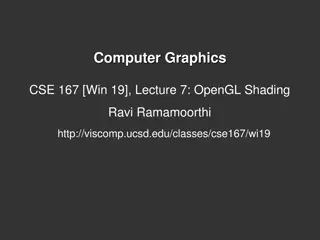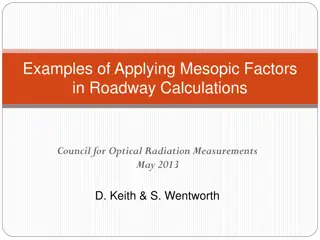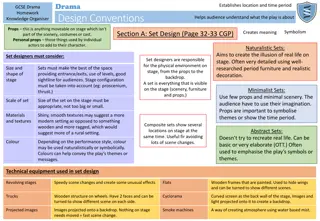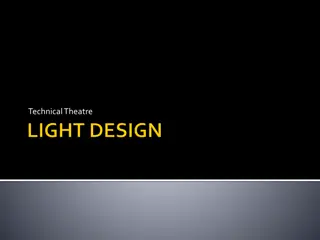Essential Factors for Optimal Lighting in Work Environments
Good lighting plays a crucial role in maintaining eye health and ensuring efficient vision. Factors such as sufficiency, uniform distribution, absence of glare and sharp shadows, steadiness, and appropriate light color are key considerations for creating a conducive work environment. Striving for optimal lighting conditions can reduce eye strain, improve visual acuity, and enhance overall productivity.
Download Presentation

Please find below an Image/Link to download the presentation.
The content on the website is provided AS IS for your information and personal use only. It may not be sold, licensed, or shared on other websites without obtaining consent from the author. Download presentation by click this link. If you encounter any issues during the download, it is possible that the publisher has removed the file from their server.
E N D
Presentation Transcript
LIGHT AND ENVIRONMENT C. B. BELLO
INTRODUCTION Good light is essential for the health of the eyes. Its essential for efficient vision. The eyes are strained when the light is inadequate When the eyes are strained, they are easily fatigued there is physical and mental discomfort and there is loss of efficiency. The following are factors that must be considered about light to ensure efficient vision:
SUFFICIENCY Lighting should be sufficient in order for the eyes to be able to see details of the object and the surroundings without eye strain. An illumination of 15 to 20 foot candles is accepted as a minimum for satisfactory vision.
DISTRIBUTION The distribution of light should be uniform with the same intensity over the whole field of work If there are difference in the intensity of light, it strains the eye and affect the visual acuity adversely. Proper dispersal of light, without the production of shadows is necessary for efficient vision.
ABSENCE OF GLARE Glare is excessive contrast, an example is the automobile headlights at night, the same light during daylight would not cause glare due to the absence of contrast. The eyes cannot tolerate glare because it causes acute discomfort and reduces critical vision Glare causes annoyance .
ABSENCE OF SHARP SHADOWS Sharp and contrasting shadows are disturbing, shadows cause confusion for the eye and therefore should not be present in the field of vision.
STEADINESS The source of light must be stable and constant. It should not flicker because flickering causes eye strain and may lead to accidents.
COLOUR OF LIGHT The colour of light is not very important as long as the intensity is adequate. Natural light has a soothing effect on the eye. Artificial light should be as far as possible be approximately like the daylight colour.
SURROUNDINGS For efficient vision, colour schemes in rooms are important. Ceiling and roof should have a reflection factor of 80%; walls 50-60%, furniture 30-40%. There should not be much reflection from the floor, not more than 15-20%. Contrasting colours are often used to prevent accidents. e. g. culverts, bridges.
MEASUREMENT OF LIGHT There are four measures of importance. There are number of terms for each of the four measures. 1) Luminous intensity- this is the power of a light source considered as a point radiating in all directions. This is measured in candelas or candle power. 2) Luminous flux- this is the flow of light related to a unit of solid angle measured in lumens. 3) Illumination or Illuminance- this is the amount of light reaching a surface measured in lux per unit area 4) Brightness or luminance- this is the amount of light reflected from a surface measured in lamberts.
NATURAL LIGHT Natural lighting is derived from the sky reflection, more light comes to the rooms by reflection from light colored objects. For efficient utilization of natural light, there is a need for a careful design of buildings, there must be proper location of buildings Natural lighting also depends upon the time of day, season, weather and atmospheric pollution. The following principles must be considered in planning for best utilization of daylight
ORIENTATION Brightness of the sky is not constant on the east and west hence illumination varies in buildings facing east or west. In the tropics, the direct penetration of sunlight from east and west may heat up the rooms unduly especially during summer. When building faces east & west, window shades should be provided to protect against the direct penetration of sunlight. Buildings should therefore be oriented towards north or south for uniform illumination. This must be put into consideration in cases of schools, factories, and laboratories where uniform lighting is required.
REMOVAL OF OBSTRUCTIONS Removal of obstruction gives the most effective improvement of lighting
WINDOWS Windows should be properly planned, as natural lighting within any room is influenced by the amount of visible sky. A tall and broad window allow greater penetration and diffusion of light into the room.
INTERIOR OF THE ROOMS In order to obtain full benefit of the natural illumination, the ceiling should be white, the upper portions of the walls light-tinted, while the lower portion darker so as to give comfortable contrast to the eyes.
ARTIFICIAL LIGHT Daylight may not produce adequate illumination all of the time, that is why there is a need to supplement with artificial light. Artificial light should be as close as possible to daylight. There are 5 systems of artificial lighting, they are: Direct lighting: this is when light 90-100% of the light is projected towards the working area, it is efficient, economical but it tends to cast sharp shadows, this should not fall into the eyes.
ARTIFICIAL LIGHT CONTD Semi-direct: 10 to 40% of the light is projected upward so that it is reflected back on the object by the ceiling. Indirect: 90 to 99% of light is projected towards the ceiling or walls, this way, light does not strike the surface directly. This gives a general illumination of the whole room but not of any object Semi-indirect: 60-90% of the light is directed upwards and the rest downwards. Direct-indirect: here light is distributed equally.
METHODS OF ARTIFICIAL ILLUMINATION 1) Filament Lamps: this are widely used, the electric current heats up the tungsten filament and the light emitted depends on the temperature. The hotter filaments produce, the bluer light. Accumulation of dust on the bulbs reduces illumination by 30-40 %. The bulbs and shades should be cleaned frequently. 2) Fluorescent Lamps: fluorescent lamps are more economical in the use of electric current, they are cool & efficient, the light emitted stimulates natural light. The lamp consist of a glass tube filled with mercury vapor and an electrode fitted at each end
METHODS OF ARTIFICIAL ILLUMINATION CONTD The inside of the tube is coated with fluorescent chemicals which absorb all the ultraviolet radiation and remit the radiation in the visible range. The total emission of energy from the 2 lamps is as follows. Light Filament 5% Fluorescent 21% Heat 95% 79%
LIGHTING STANDARD The eye responds to a range of illumination ranging from 0.1 lux (full moonlight night) to 100,000 lux (bright sunshine). Because of the adaptability of the eyes, there are confusion about standards that have been published. There are no exact lighting standards, The visual efficiency increases with increase illumination but the curve flattens out at higher levels. The rule of thumb is that the illumination level should be 30times higher than the level at which the task can just be done.
LIGHTING STANDARD CONTD The following values in lux have been suggested by the Illuminating Engineer Society. Visual task Casual reading General office work Fine assembly Very severe task Watch making Illumination (lux) 100 400 900 1,300-2,000 2,000-3,000
BIOLOGIC EFFECT OF LIGHT Daylight is capable of causing in vitro degradation of bilirubin, and this is used as a therapeutic measure in premature infants with hyperbilirubinaemia Light is noted for stimulation of melanin synthesis
REFERENCES Park, K. (2005) Park s Textbook of Preventive and Social Medicine Banarsidas Bhanot publishers Nagar India Basavanthappa, B. T. (2008) Community Health Nursing, Jaypee Brothers Medical Publishiners (P) Ltd.
THANKS FOR LISTENING

























